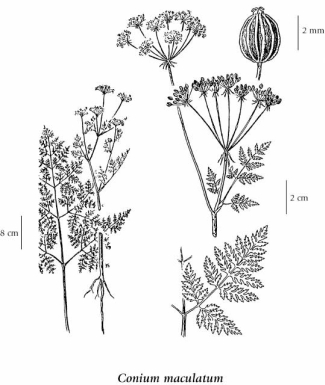Conium maculatum L.
poison-hemlock (poison hemlock)
Apiaceae
Introduction to Vascular Plants
poison-hemlock (poison hemlock)
Apiaceae
Introduction to Vascular Plants
Species Information
General:
Robust biennial herb from a stout whitish taproot, with a disagreeable odour, especially when crushed; stems erect, freely branched, purple-blotched, hollow, 0.5-3 m tall, glabrous, glaucous.
Leaves:
Stem leaves pinnately dissected, fernlike, with small ultimate segments giving the plant a lacy appearance; leaf stalks enlarged and sheathing at the base, the blades 15-30 cm long.
Flowers:
Inflorescence terminal and axillary in many compound umbels; flowers white; involucral bracts small, lance-shaped.
Fruits:
Egg-shaped, somewhat flattened, 2-2.5 mm long, glabrous, with prominent, raised, often wavy ribs.
Notes:
Plants highly poisonous.
Illustration

If more than one illustration is available for a species (e.g., separate illustrations were provided for two subspecies) then links to the separate images will be provided below. Note that individual subspecies or varietal illustrations are not always available.
Illustration Source: The Illustrated Flora of British Columbia
Ecology
Ecological Framework for Conium maculatum
The table below shows the species-specific information calculated from
original data (BEC database) provided by the BC Ministry of Forests and Range.
(Updated August, 2013)
The table below shows the species-specific information calculated from
original data (BEC database) provided by the BC Ministry of Forests and Range.
(Updated August, 2013)
| Site Information |
Value / Class |
||
|
Avg |
Min |
Max |
|
| Elevation
(metres) |
1429 | 1359 | 1500 |
| Slope
Gradient (%) |
10 | 0 | 20 |
|
Aspect (degrees) |
120 | 120 | 120 |
| Soil
Moisture Regime (SMR) [0 - very xeric; 4 - mesic; 8 - hydric] |
5 | 5 | 5 |
| Modal
Nutrient Regime
Class |
D | ||
| #
of field plots species was recorded in: |
2 | ||
| Modal
BEC Zone Class |
ICH | ||
|
All BEC Zones (# of stations/zone) species was recorded in |
ICH(1), MS(1) | ||
|
Source:
Klinkenberg 2013
|
|||
Habitat and Range
Wet to mesic ditches and disturbed sites in the lowland zone; locally common in in SW BC (known in the Victoria area and Vancouver) rare in SC BC; introduced from Europe.Status Information
Taxonomic Notes
This is an extremely poisonous introduced European species in the carrot/parsley family (Apiaceae/Umbelliferae) that can be fatal if ingested. Because it is so toxic, it is important to carefully consider the key characteristics when making an identification. This is the plant that Socrates used to kill himself (Pojar and MacKinnon 1994).
Note Author: R. Klinkenberg References Pojar, Jim and Andy MacKinnon. 1994. Plants of Coastal British Columbia. Lone Pine Press, Edmonton. |